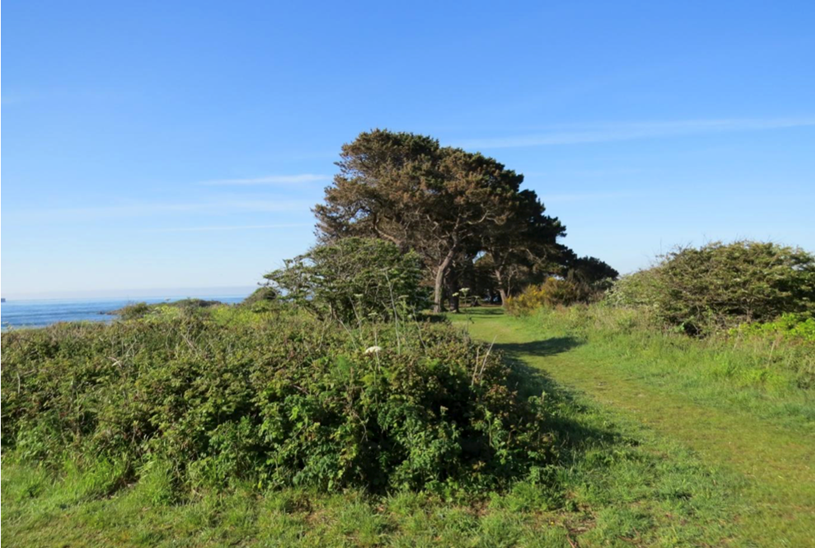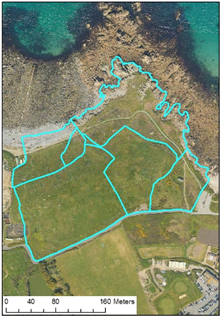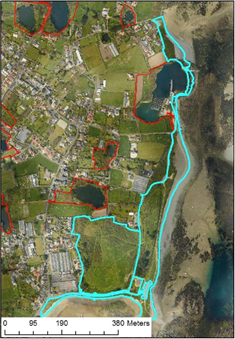Vale is tops for biodiversity sites, report finds
Mon 13 Mar 2023

The area of biodiversity importance identified at Bordeaux
Bordeaux ranked No 1 with 13 points and Creve Coeur second with 12. This is a reflection of the importance of the habitat itself and the rariety of species found there. Also nominated for designation are the cemeteries at the Vale Church.
Environment Guernsey, which was contracted by the States Planning Service to conduct the survey in 2021, said of the former landfill sites: "These are relatively large sites and it is to be expected that, in addition to hosting a wide range of plant and bird species, both supported a range of different habitats."
Of the Vale Church, it said: "All local churchyards support permanent grassland habitats which in many cases have become relatively species-rich over time. The plant diversity of a churchyard is closely linked to the management regime which varies in terms of mowing frequency and the use of chemicals such as herbicides and fertilisers. Despite the different maintenance operations, most churchyards scored highly for plant diversity."
The habitat there is dune grassland with scattered trees and was particularly notable for the plant Four-leaved Allseed (Polycarpon tetraphyllumis) of which there are fewer than 100 known sites in the British Isles.
The information on the proposed new ABIs was released by the Development and Planning Authority as part of what it is calling a focused review of certain policies within the Island Development Plan (IDP), which has been widely criticised for allowing agricultural land to become domestic gardens, providing insufficient affordable housing and concentrating too much development in the north of the island.
The report itself can be found in the downloads section below.
Consultation
Senior Constable Richard Leale said the douzaine had been approached by the DPA as part of its review consultation and members were considering its response.
"This is a complex area and, since the IDP has a 10-year lifespan, the policies in it have wide-ranging and long-term consequences – especially if they are the wrong policies."
He said that the recommendations for the new APIs reflected that. "We welcome the inclusion of the new sites but the report shows quite clearly that it's how we manage and protect these area that's important and the Vale and St Sampson's have been swamped with proposed and actual developments in recent years."
He said the parish would take some time to consider its response and said they would welcome feedback from parishioners on the review (details below). In the meantime, the new APIs, he said, showed that there was a lot in the north that warranted preserving, which the parish would endeavour to do.
Creve Coeur
 Site description: A former landfill site which has been restored to coastal grassland and associated habitats.
Site description: A former landfill site which has been restored to coastal grassland and associated habitats.
Size: 5.72ha.
Owners: States of Guernsey.
Habitats: Coastal Grassland, Dense Scrub, Dune Grassland. Also Rock, Continuous Bracken and Dune Scrub.
Notable species – Plants: Wild Leek (Allium ampeloprasum) - <250 sites in the British Isles. Teasel (Dipsacus fullonum) - rare locally.
Indian Strawberry (Potentilla indica) and Brown Knapweed (Centaurea jacea) originate from a seed mix sown on the land as part of the restoration.
Notable species - Birds: Song Thrush (Turdus philomelos) Starling (Sturnus vulgaris), House Sparrow (Passer domesticus) and Linnet (Linaria cannabina) are all UK red-listed. Also Swallow (Hirundo rustica), Stonechat (Saxicola rusticola), Whitethroat (Sylvia communis) and migrant Honey Buzzard (Pernis apivorus).
Threats: Scrub encroachment, invasive non-native species such as Pampas grass, human disturbance. Recommended management: The grassland habitats should be cut annually and the associated scrub kept in check. Annual grazing by cattle or sheep would be beneficial.
Bordeaux landfill site
 Site description: A former landfill site restored as a natural mound (Hougue) and associated coastal strip.
Site description: A former landfill site restored as a natural mound (Hougue) and associated coastal strip.
Size: 10.19ha.
Owners: States of Guernsey and private.
Habitats: Semi-improved Grassland, Tall Ruderal, Dense Scrub, Coastal Grassland, Shingle, Dune Grassland, Dune Scrub. Also Planted Broadleaved Woodland, Planted Coniferous Woodland.
Notable species – Plants: Loose-flowered Orchid (Anacamptis laxiflora) - <25 sites in the British Isles. Hairy Bird’s-foot-trefoil (Lotus subbiflorus), Small-flowered Catchfly (Silene gallica), Yellow Vetch (Vicia lutea) and Toothed Medick (Medicago polymorpha) - <100 sites in the British Isles. Ivy Broomrape (Orobanche hederae) and Subterranean Clover (Trifolium subterraneum) - <250 sites in the British Isles.
Notable species – Birds: Song Thrush (Turdus philomelos), Starling (Sturnus vulgaris), Linnet (Linaria cannabina) and House Sparrow (Passer domesticus) are all UK red-listed. Also Swallow (Hirundo rustica), Whitethroat (Sylvia communis), Chiffchaff (Phylloscopus collybita), migrant Spotted Flycatcher (Muscicapa striata).
Threats: Scrub encroachment of sensitive grassland habitats, coastal erosion, human disturbance, lack of appropriate management of grasslands, invasive non-native species such as sour fig (Carpobrotus edulis).
Recommended management: Grassland habitats should be cut annually and the cuttings removed. Associated scrub areas should be kept in check every 1-2 years.

